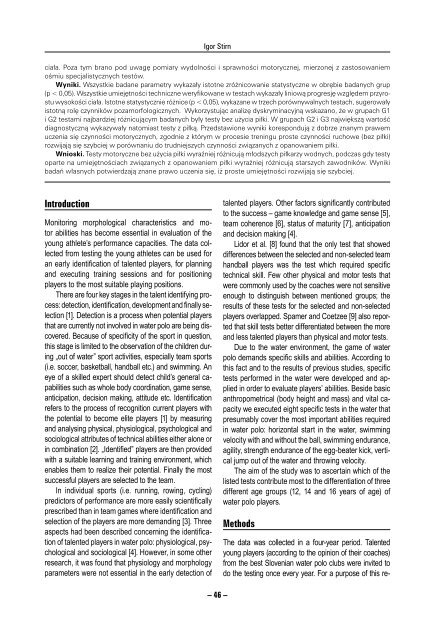Antropomotoryka nr 51 - Akademia Wychowania Fizycznego w ...
Antropomotoryka nr 51 - Akademia Wychowania Fizycznego w ...
Antropomotoryka nr 51 - Akademia Wychowania Fizycznego w ...
- No tags were found...
Create successful ePaper yourself
Turn your PDF publications into a flip-book with our unique Google optimized e-Paper software.
Igor Stirnciała. Poza tym brano pod uwagę pomiary wydolności i sprawności motorycznej, mierzonej z zastosowaniemośmiu specjalistycznych testów.Wyniki. Wszystkie badane parametry wykazały istotne zróżnicowanie statystyczne w obrębie badanych grup(p < 0,05). Wszystkie umiejętności techniczne weryfikowane w testach wykazały liniową progresję względem przyrostuwysokości ciała. Istotne statystycznie różnice (p < 0,05), wykazane w trzech porównywalnych testach, sugerowałyistotną rolę czynników pozamorfologicznych. Wykorzystując analizę dyskryminacyjną wskazano, że w grupach G1i G2 testami najbardziej różnicującym badanych były testy bez użycia piłki. W grupach G2 i G3 największą wartośćdiagnostyczną wykazywały natomiast testy z piłką. Przedstawione wyniki korespondują z dobrze znanym prawemuczenia się czynności motorycznych, zgodnie z którym w procesie treningu proste czynności ruchowe (bez piłki)rozwijają się szybciej w porównaniu do trudniejszych czynności związanych z opanowaniem piłki.Wnioski. Testy motoryczne bez użycia piłki wyraźniej różnicują młodszych piłkarzy wodnych, podczas gdy testyoparte na umiejętnościach związanych z opanowaniem piłki wyraźniej różnicują starszych zawodników. Wynikibadań własnych potwierdzają znane prawo uczenia się, iż proste umiejętności rozwijają się szybciej.IntroductionMonitoring morphological characteristics and motorabilities has become essential in evaluation of theyoung athlete’s performance capacities. The data collectedfrom testing the young athletes can be used foran early identification of talented players, for planningand executing training sessions and for positioningplayers to the most suitable playing positions.There are four key stages in the talent identifying process:detection, identification, development and finally selection[1]. Detection is a process when potential playersthat are currently not involved in water polo are being discovered.Because of specificity of the sport in question,this stage is limited to the observation of the children during„out of water” sport activities, especially team sports(i.e. soccer, basketball, handball etc.) and swimming. Aneye of a skilled expert should detect child’s general capabilitiessuch as whole body coordination, game sense,anticipation, decision making, attitude etc. Identificatio<strong>nr</strong>efers to the process of recognition current players withthe potential to become elite players [1] by measuringand analysing physical, physiological, psychological andsociological attributes of technical abilities either alone orin combination [2]. „Identified” players are then providedwith a suitable learning and training environment, whichenables them to realize their potential. Finally the mostsuccessful players are selected to the team.In individual sports (i.e. running, rowing, cycling)predictors of performance are more easily scientificallyprescribed than in team games where identification andselection of the players are more demanding [3]. Threeaspects had been described concerning the identificationof talented players in water polo: physiological, psychologicaland sociological [4]. However, in some otherresearch, it was found that physiology and morphologyparameters were not essential in the early detection oftalented players. Other factors significantly contributedto the success – game knowledge and game sense [5],team coherence [6], status of maturity [7], anticipationand decision making [4].Lidor et al. [8] found that the only test that showeddifferences between the selected and non-selected teamhandball players was the test which required specifictechnical skill. Few other physical and motor tests thatwere commonly used by the coaches were not sensitiveenough to distinguish between mentioned groups; theresults of these tests for the selected and non-selectedplayers overlapped. Spamer and Coetzee [9] also reportedthat skill tests better differentiated between the moreand less talented players than physical and motor tests.Due to the water environment, the game of waterpolo demands specific skills and abilities. According tothis fact and to the results of previous studies, specifictests performed in the water were developed and appliedin order to evaluate players’ abilities. Beside basicanthropometrical (body height and mass) and vital capacitywe executed eight specific tests in the water thatpresumably cover the most important abilities requiredin water polo: horizontal start in the water, swimmingvelocity with and without the ball, swimming endurance,agility, strength endurance of the egg-beater kick, verticaljump out of the water and throwing velocity.The aim of the study was to ascertain which of thelisted tests contribute most to the differentiation of threedifferent age groups (12, 14 and 16 years of age) ofwater polo players.MethodsThe data was collected in a four-year period. Talentedyoung players (according to the opinion of their coaches)from the best Slovenian water polo clubs were invited todo the testing once every year. For a purpose of this re-– 46 –





![Antropomotoryka nr 57 [2012]. - Akademia Wychowania Fizycznego ...](https://img.yumpu.com/50213388/1/182x260/antropomotoryka-nr-57-2012-akademia-wychowania-fizycznego-.jpg?quality=85)










